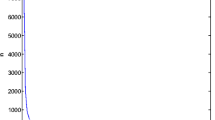Abstract
We show that from a communication-complexity perspective, the primitive called oblivious transfer—which was introduced in a cryptographic context—can be seen as the classical analogue to a quantum channel in the same sense as non-local boxes are of maximally entangled qubits. More explicitly, one realization of non-cryptographic oblivious transfer allows for the perfect simulation of sending one qubit and measuring it in an orthogonal basis. On the other hand, a qubit channel allows for realizing non-cryptographic oblivious transfer with probability roughly 85 %, whereas 75 % is the classical limit.





Similar content being viewed by others
References
Ambainis A, Nayak A, Ta-Shma A, Vazirani U (1998) Dense quantum coding and a lower bound for 1-way quantum automata. quant-ph/9804043
Bell JS (1964) On the Einstein–Podolsky–Rosen paradox. Physics 1:195–200
Bennett CH, Brassard G, Crépeau C, Jozsa R, Peres A, Wootters W (1993) Teleporting an unknown quantum state via dual classical and EPR channels. Phys Rev Lett 70:1895–1899
Buhrman H, Christandl M, Unger F, Wehner S, Winter A (2006) Implications of superstrong nonlocality for cryptography. Proc R Soc A 462(2071):1919–1932, quant-ph/0504133
Cerf N, Gisin N, Massar S (2000) Classical teleportation of a quantum bit. Phys Rev Lett 84(11):2521–2524
Cerf N, Gisin N, Massar S, Popescu S (2005) Simulating maximal quantum entanglement without communication. Phys Rev Lett 94:220403
Devetak I, Harrow AW, Winter AJ (2004) A family of quantum protocols. Phys Rev Lett 93(23):230504
Devetak I, Harrow AW, Winter AJ (2008) A resource framework for quantum Shannon theory. IEEE Trans Inf Theory 54(10):4587–4618
Einstein A, Podolsky B, Rosen N (1935) Can quantum-mechanical description of physical reality be considered complete? Phys Rev 41:777–780
Gleason AM (1957) Measures on the closed subspaces of a Hilbert space. J Math Mech 6:885
Jauch JM, Piron C (1963) Can hidden variables be excluded in quantum mechanics? Helv Phys Acta 36:827
Kochen S, Specker E (1967) The problem of hidden variables in quantum mechanics. J Math Mech 17(1):59–87
Popescu S, Rohrlich D (1994) Quantum nonlocality as an axiom. Found Phys 24:379–385
Rabin M (1981) How to exchange secrets by oblivious transfer. Technical Report TR-81, Harvard Aiken Computation Laboratory
Specker E (1960) Die Logik nicht gleichzeitig entscheidbarer Aussagen. Dialectica 14:239–246
Toner B, Bacon D (2003) Communication cost of simulating Bell correlations. Phys Rev Lett 91(18):187904
von Neumann J (1955) Mathematische Grundlagen der Quanten-Mechanik. Verlag Julius-Springer, Berlin, 1932. Mathematial foundations of quantum mechanics. Princeton University, Princeton
Wiesner S (1983) Conjugate coding. Sigact News 15(1):78–88
Wolf S, Wullschleger J (2006) Oblivious transfer is symmetric. In: Advances in cryptology—EUROCRYPT ’06, volume 4004 of Lecture Notes in Computer Science. Springer, pp 222–232
Acknowledgments
This work was supported by the Swiss National Science Foundation (SNF). We thank the anonymous reviewers for their valuable comments on this work.
Author information
Authors and Affiliations
Corresponding author
Rights and permissions
About this article
Cite this article
Gisin, N., Popescu, S., Scarani, V. et al. Oblivious transfer and quantum channels as communication resources. Nat Comput 12, 13–17 (2013). https://doi.org/10.1007/s11047-012-9350-9
Published:
Issue Date:
DOI: https://doi.org/10.1007/s11047-012-9350-9




